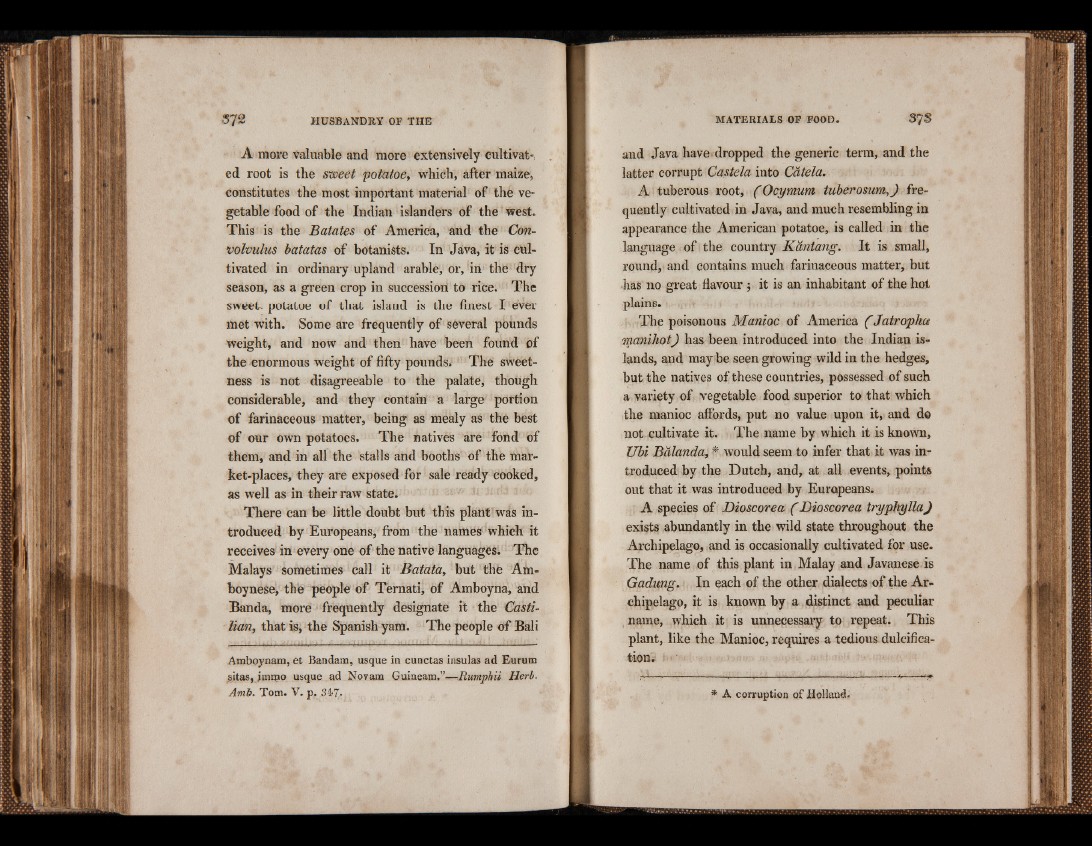
A more Valuable and more extensively cultivated
root is the sweet potatoe, which, after maize,
constitutes the most important material of the vegetable
food of the Indian islanders of the west.
This is the Batates of America, and the Convolvulus
batatas of botanists. In Java, it is cultivated
in ordinary upland arable, or, in the dry
season, as a green crop in succession to rice. The
swéet- potatoe of that island is the finest I ever
met with. Some are frequently of several pounds
weight, and now and then have been found of
the enormous weight of fifty pounds. The sweetness
is not disagreeable to the palate, though
considerable, and they contain a large portion
of farinaceous matter, being as mealy as the best
of our own potatoes. The natives are fond of
them, and in all the stalls and booths of the market
places, they are exposed for sale ready cooked,
as well as in their raw state.
There can be little doubt but this plant was introduced
by Europeans, from the names which it
receives in every one of the native languages. The
Malays sometimes call it Batata, but the Amboy
nese, the people of Teraati, of Amboyna, and
Banda, more frequently designate it the Castilian,
that is, the Spanish yam. The people Of Bali
Amboynam, et Bandam, usque in cunetas Ínsulas ad Eurum
sitas, ¿mino usque ad Novam Guineam.”— Rumphii Herb.
Amb. Tom. V. p. 3^7-
and Java have dropped the generic term, and the
latter corrupt Castela into Cdtela.
A tuberous root, ( Ocymum tuberosum,J frequently
cultivated in Java, and much resembling in
appearance the American potatoe, is called in the
language of the country Kantang. It is small,
round, and contains much farinaceous matter, but
has no great flavour 5 it is an inhabitant of the hot
plains.
The poisonous Manioc of America ( Jatrophu
manihot) has been introduced into the Indian islands,
and may be seen growing wild in the hedges,
but the natives of these countries, possessed of such
a variety of vegetable food superior to that which
the manioc affords, put no value upon it, and do
not cultivate it. The name by which it is known,
Ubi Balanda, * would seem to infer that it was introduced
by the Dutch, and, at all events, points
out that it was introduced by Europeans.
A species of Dioscorea ( JDioscorea tryphyllaJ
exists abundantly in the wild state throughout the
Archipelago, and is occasionally cultivated for use.
The name of this plant in Malay and Javanese is
Gadung. In each of the other dialects of the Archipelago,
it is known by a distinct and peculiar
name, which it is unnecessary to repeat. This
plant, like the Manioc, requires a tedious dulcifica-
tion.
* A corruption of Holland.